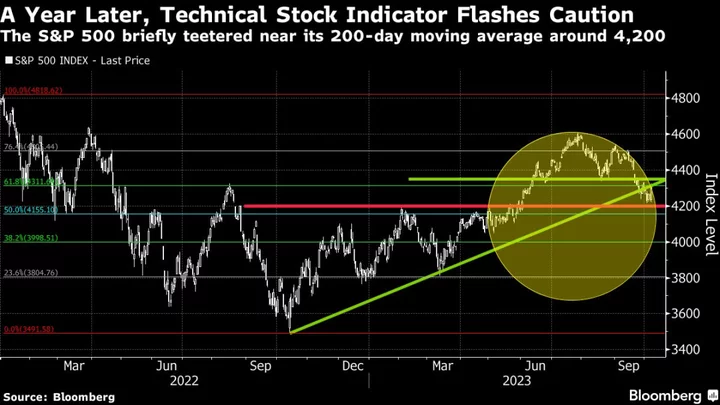It was supposed to be one of the greatest stock-market comebacks of all time. But after a summer slump, there’s a nagging fear it might just keep slipping away.
Roughly a year after the S&P 500 Index bottomed out, money managers have seen the stock market’s gains erode on expectations the Federal Reserve will keep interest rates elevated well into next year.
More than 180 stocks in the benchmark are now trading for less than they were 12 months ago, even after the equity market snapped a four-week losing streak with a rally Friday that drove it to a small gain. And in a little over two months, more than a third of the S&P 500’s advance this year has been erased, sapping investors’ confidence and sowing fear that equities have further to fall.
Take Bank of America Corp. strategist Michael Hartnett, who’s advising clients to pull back from US stocks because he’s “convinced the bear market has unfinished business.”
If the selling revives and the S&P 500 falls below 4,200, there are few breakout levels where buyers could safely swoop in, according to technical analysts who monitor daily averages and other metrics as a gauge of stock-market momentum. It closed Friday at 4,309.
That leaves the index vulnerable to sliding to its March lows around 3,900 — or even further. For bulls to have the upper hand once again, the S&P 500 would likely need to hold above its June lows of around 4,350.
Of course, the S&P 500 remains up more than 12% for the year. The recent downturn was driven by the interest-rate risk posed by the persistent strength of the economy, not a slowdown that would batter corporate profits, and Friday’s gain in the face of unexpectedly strong employment data shows the market is proving resilient.
Moreover, the S&P 500 has never hit a new low after rising as much as it has since last October. To cross that line it would need to fall nearly 17%.
Sam Stovall, chief investment strategist at research firm CFRA, said a retrenchment of that scale remains unlikely and he’s sticking to his 4,575 year-end price target for the S&P 500, implying a further gain of some 6%. But he’s still nursing doubts about how long such strength could persist.
“My real worry is does this bull market die an early death, or do we end up with a new all-time high and worry instead about what happens in 2024?” he said.
The post-pandemic economy has fed such doubts by consistently catching markets by surprise, first with the persistence of inflation and now with how resistant it has been to the Fed’s most aggressive rate hikes in four decades. Yet that strength is a double-edged sword: By giving the central bank reason to keep rates elevated, it’s also increasing the risk that parts of the economy will snap, resulting in a recession instead of the soft landing investors had started betting on.
Such concerns have weighed on investor sentiment. A poll of investment advisers from 125 firms by the National Association of Active Investment Managers showed their equity exposure fell to 36% last week, less than it was at this time a year ago.
The current view among investors is that “the economy remains resilient, meaning the Fed will remain restrictive, yields will likely keep rising and stocks will continue to decline,’” said Chris Zaccarelli, chief investment officer for Independent Advisor Alliance. “Eventually, the higher-for-longer environment will cause something to break.”
At the same time, the payouts on short-term Treasuries and other low-risk investments have pushed over 5%, giving investors another incentive to pull back from equities. Nearly $71 billion was poured into cash-like instruments during the week ended Wednesday, the biggest inflow since July, according to Bank of America, which cited EPFR Global data.
From a contrarian standpoint, that means investors are sitting on a lot of money that could be used to buy equities when sentiment eventually turns around. Although October has a bad reputation for stocks, it’s historically a seasonally better time for investors following the worst two months of the year for equities, according to Stovall.
Investors are waiting for earnings reports in the coming weeks that will show how much of the economy’s recent strength has filtered down to corporate profits, particularly for the big technology companies that were responsible for much of this year’s stock-market gains. The companies in the S&P 500 are expected to notch the fourth straight quarter of profit declines, data compiled by Bloomberg Intelligence show, but they will also provide outlooks for where earnings are headed.
“Not all of the stock market was whistling past the graveyard of uncertainties over the past year,” said Liz Ann Sonders, chief investment strategist at Charles Schwab. “But the trifecta of spiking bond yields, with a rising dollar and higher oil prices, has become too much for the stock market.”

